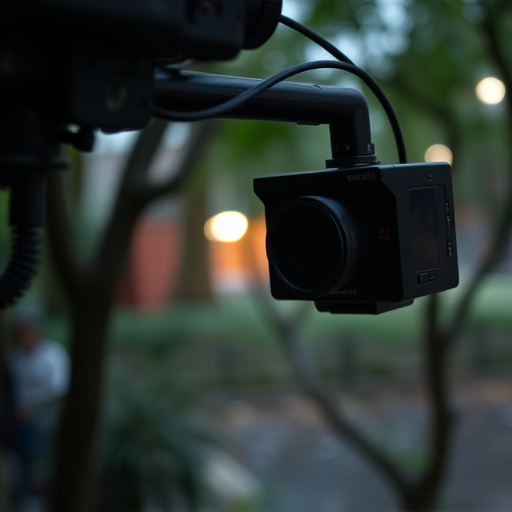Electromagnetic (EM) signals are crucial for detecting hidden cameras used for surveillance. Skilled professionals utilize specialized equipment like EM field detectors and RF signal analyzers to identify unique device signatures within the electromagnetic spectrum. By analyzing signal patterns, they can locate and disable covert cameras, enhancing security and privacy. This process requires consideration of environmental factors and a systematic scanning technique to overcome interference. Safety measures, including protective gear and expert consultation, are essential when dealing with hidden cameras and EM signals to ensure well-being during sensitive operations.
Uncover the world of hidden cameras and intruder signals with our comprehensive guide. In an era where privacy is paramount, understanding electromagnetic (EM) signals becomes a powerful tool for detection. We explore the science behind EM signals and their role in revealing covert surveillance devices. From advanced technologies to strategic locational tactics, this article equips you with the knowledge to identify and locate hidden cameras. Discover best practices and safety precautions to ensure your privacy and become an adept detector in today’s digital landscape.
- Understanding Electromagnetic Signals and Their Role in Detection
- Tools and Technologies for Intruder Signal Identification
- Strategies to Locate Hidden Cameras Using EM Signals
- Best Practices and Precautions for Safe Signal Detection
Understanding Electromagnetic Signals and Their Role in Detection
Electromagnetic signals are integral to modern technology, including hidden cameras used for surveillance and detecting intruders. These signals, often invisible to the naked eye, carry information that can reveal the presence of covert devices. Understanding electromagnetic waves, their frequencies, and wavelengths is crucial in identifying these hidden signals. Each type of device emits unique signatures, making it possible to detect and pinpoint their locations.
When searching for hidden cameras or intruders, experts focus on specific bands within the electromagnetic spectrum. For instance, radio frequency (RF) signals used by wireless cameras can be detected using specialized equipment that tunes into these frequencies. By analyzing the patterns and strengths of these signals, individuals skilled in surveillance art can uncover clandestine observation devices, ensuring a more comprehensive approach to security and privacy protection.
Tools and Technologies for Intruder Signal Identification
In the quest to uncover hidden cameras and detect intruders, professionals rely on a suite of sophisticated tools and technologies. One of the most effective methods is Electromagnetic (EM) field detection, which can identify devices emitting unique electromagnetic signals, including hidden cameras. These sensors are adept at picking up subtle variations in EM fields caused by the power consumption of surveillance equipment.
Additionally, Radio Frequency (RF) signal analyzers play a pivotal role in intruder identification. These devices scan for specific frequencies and protocols commonly associated with hidden cameras and other tracking devices. By analyzing the signals, experts can pinpoint the location and type of device, making it easier to detect and dismantle covert surveillance setups.
Strategies to Locate Hidden Cameras Using EM Signals
Detecting hidden cameras using electromagnetic (EM) signals is a valuable skill, especially for professionals tasked with ensuring privacy and security. One effective strategy involves utilizing specialized equipment to analyze EM radiation patterns. By scanning for anomalies in electromagnetic fields, experts can identify devices emitting signals that might indicate the presence of hidden cameras. These tools can detect even subtle emissions from low-power cameras, making them ideal for discreet operations.
When navigating environments with potential hidden cameras, it’s crucial to consider environmental factors that may interfere with EM signals. Materials like metal and concrete can reflect or absorb these signals, affecting detection accuracy. Therefore, professionals should employ a systematic approach, moving methodically through areas of interest while accounting for such obstacles. This methodical scanning technique enhances the chances of locating hidden cameras, ensuring effective intrusion detection.
Best Practices and Precautions for Safe Signal Detection
When engaging in hidden cameras detecting intruders or electromagnetic signal detection, safety should always be a top priority. To ensure your well-being and avoid any potential hazards, several best practices must be followed. First, it’s crucial to wear protective gear, including insulated gloves and a Faraday cage vest, especially when handling unknown devices to prevent accidental shocks or interference from other electronic equipment. Additionally, maintain a safe distance from suspected surveillance devices to minimize exposure to electromagnetic fields. Regularly calibrate your detection equipment to ensure accurate readings, and keep detailed records of all findings for future reference.
Precautions are also vital during the detection process. Avoid conducting searches in areas with active electrical systems or signal transmissions unless you have the necessary expertise and de-escalation strategies. Never touch or manipulate devices that appear damaged or suspicious; instead, document their location and consult a professional. Remember, hidden cameras detecting intruders is a delicate task, and your safety should never be compromised. Always prioritize caution, stay alert, and seek expert assistance when needed.
In the battle against hidden cameras and detecting intruders, understanding electromagnetic (EM) signals is a game-changer. This article has equipped readers with the knowledge of EM signal detection, from recognizing their role in surveillance to employing advanced tools and strategies. By mastering these techniques, individuals can navigate the intricate landscape of signal identification, location, and safe detection practices. Remember that staying informed about these methods is crucial for safeguarding privacy and preventing unlawful surveillance.
